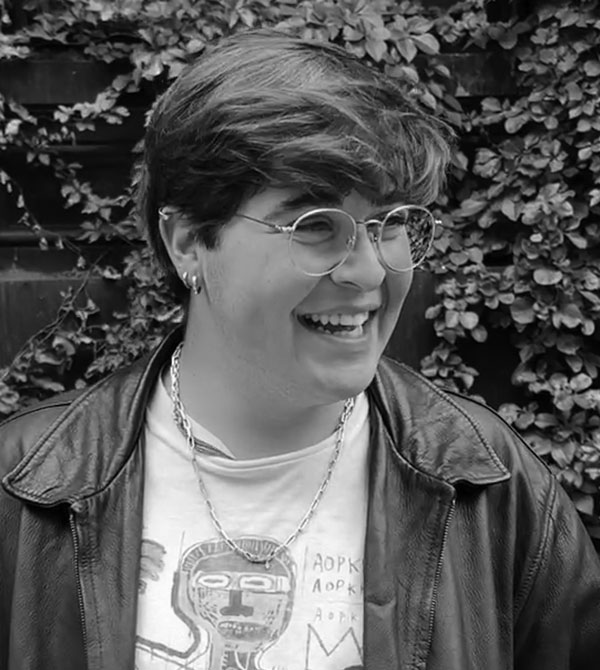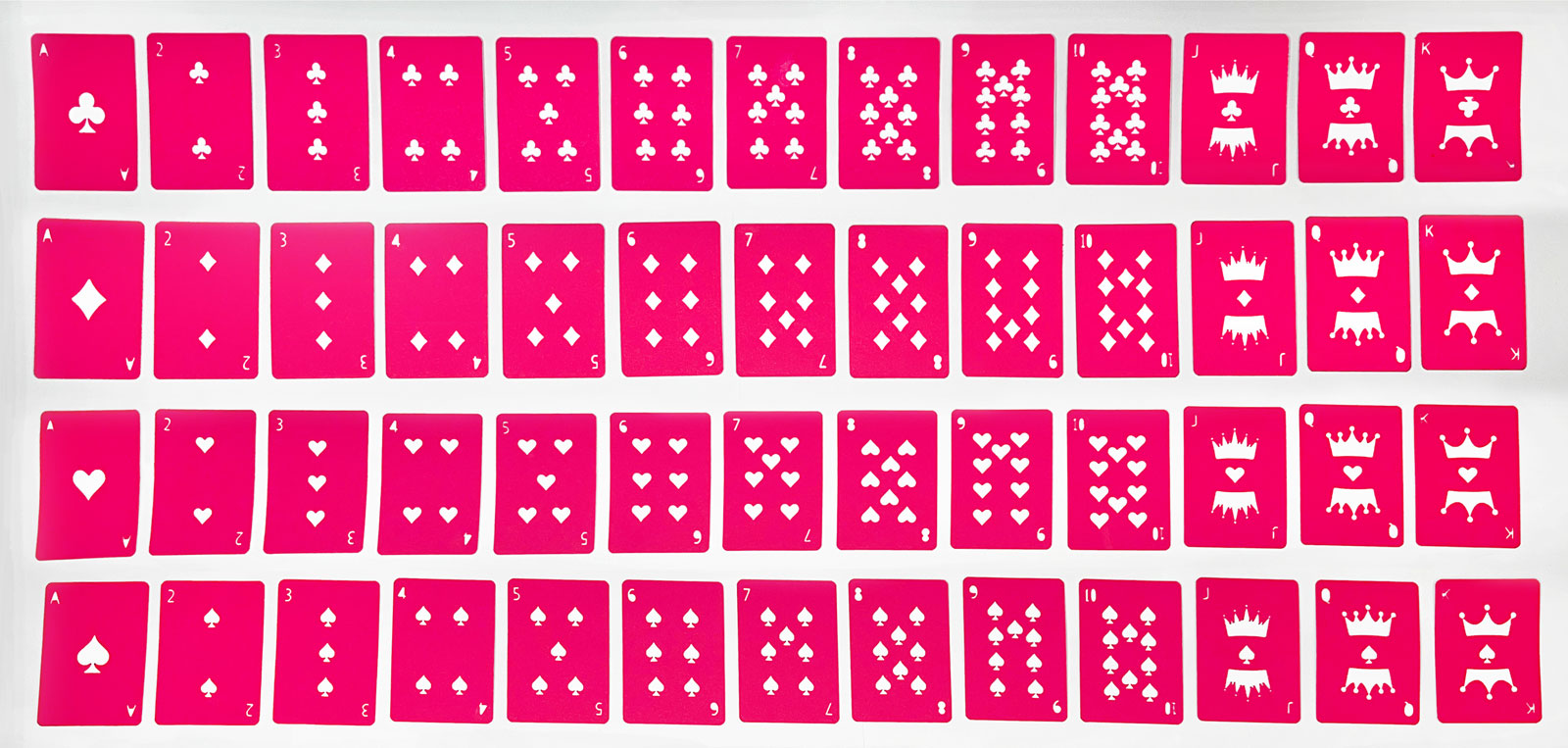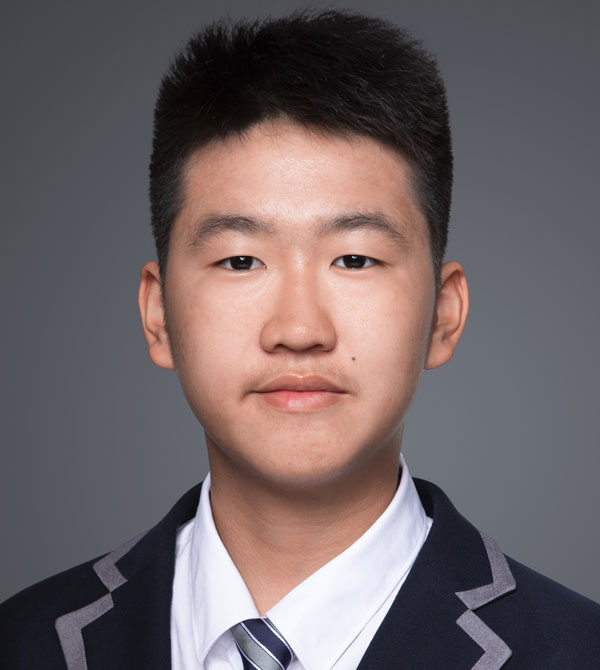

AP 3-D
Clayton High School|Saint Louis, Missouri
Zachary Millner
Millner

Dimensions: 20” x 8” x 7”|Idea(s): The thing used to put out fires is burning. Somebody get a fire extinguisher to put it out! Oh...|Material(s): Performance: Photo documentation of mixed media sculpture, perforated hanging strips, nuts, and bolts.|Process(es): Cage of fire extinguisher filled with paper, then burned for an unexpected and absurd situation.|Curatorial Note: This is a unique approach to create an image of a fire extinguisher that pushes further with the performative act of filling it with paper and setting it on fire then leaving the ashes. Documenting the process with a deep red background makes it an even more powerful statement.
Student statement
Student statement
In my sustained investigation, I explored the intricate world of irony, experimenting with different forms, such as situational, dramatic, and literal irony. I worked to add a sense of whimsy, absurdity, and humor into my art, aiming to create a captivating and engaging experience for my audience.
To achieve this, I experimented with contrasting elements like colors, textures, and media to establish an atmosphere that defied expectations. The two selected pieces from my portfolio, "Uh… Is There A Different Extinguisher Anywhere?" and "Call My Bluff And See It Too," embody the essence of my inquiry. They both have ironic meanings that differ significantly from the original intentions of the objects they depict.
"Uh… Is There A Different Extinguisher Anywhere?" portrays a fire extinguisher engulfed in flames, a visual irony where the tool meant to extinguish fires is itself on fire. "Call My Bluff And See It Too" features a see-through deck of cards, contrasting the secrecy of traditional card games.
My inquiry into irony was rooted in my passion for exploring life's whimsical, absurd, and humorous parts. As my portfolio evolved, so did my inquiry, progressing from an essential exploration of irony to a deeper investigation of how to convey humor and irony within my art. This transformation allowed me to involve my audience in my work, transforming my previously static creations into interpretative experiences.
I incorporated performance elements into my art, such as in "Deception of Joy," where my art interacted with friends to create dramatic irony. My art became a shared experience, inviting others to join me in exploring life's lighter, more humorous side.
I consider sharing my work as a performance, an invitation for others to partake in the fun, and a reminder that there's always room for playfulness and levity in our lives. This evolution of my inquiry led me to unlock a previously undiscovered dimension of my artistic practice.
As my portfolio developed, my writing evolved alongside it. I began to perceive the world in a new, exploratory way, which influenced my writing style. My writing became more reflective and expressive, articulating the intricacies of irony in my work and the impact of my artistic choices.
In developing my portfolio, I practiced and experimented with various mediums, colors, and performance elements to infuse whimsy, absurdity, humor, and contrast into my pieces. Unconventional materials, including irons, anchovy tins, cinder blocks, and metal items, were strategically chosen to introduce humor and contrast. I used bright colors to add playfulness and absurdity, enhancing the overall impact of my work.
My approach also involved constant revisions, allowing me to adapt my pieces to the dynamic creative process. My ideas frequently evolved as I interacted with different materials and processes, leading to unexpected outcomes. The intentional selection of materials and development of processes played a vital role in shaping the meaning and creation of my artwork.
Every material chosen was carefully aligned with the essence of the idea behind the piece. Embracing various media allowed me to explore numerous methods and techniques, broadening my creative horizons. I drew inspiration from contemporary and historical artmaking styles, practices, and traditions. Many of my works exhibit characteristics of pop art, influenced by famous pieces such as Andy Warhol's "Kimiko."
My art teacher, Ms. Chavarin, provided invaluable support throughout my creative journey. She allowed me to explore my ideas in a way that felt true to my artistic vision while stepping in when guidance was needed. Her unwavering support allowed me to feel comfortable in my artistic skin, fostering an environment of experimentation without the fear of failure. This support significantly shaped my artistic development, instilling confidence in my creative process.
Regarding advice for future AP Art and Design students, remember to embrace the fluidity of the creative process and don't be afraid to let your work evolve. Experimentation is vital to artistic growth, so lean into it and relish the experience.
As my portfolio developed, my inquiry transformed, leading me to explore uncharted territories and discover facets of my artistic practice I never knew existed. Embrace the unexpected, cherish the journey of self-expression, and invite others to join in the fun.
As my portfolio developed, my inquiry transformed, leading me to explore uncharted territories and discover facets of my artistic practice I never knew existed. Embrace the unexpected, cherish the journey of self-expression, and invite others to join in the fun.
Dimensions: 4” x 3” x 2”|ldea(s): Can you play a classic secretive game if you can't hide anything? Ruins the whole game, doesn't it?|Materials: Pink Cardstock.|Process(es): Uses bright pink to show the absurd twist of traditional childhood game. Cards colorful, not white.

I practiced and experimented with medium, color, historical inspiration, and performance elements to add whimsy, absurdity, humor, and contrast to my work. Unconventional materials like irons, anchovy tins, cinder blocks, and metal items (brought humor and contrast). Bright colors added playfulness and absurdity.
TEacher statement
TEacher statement

Kami Chavarin
The inquiry-based learning in the AP Art and Design program is so powerful for developing young artists’ sense of who they are and the ideas they want to express through their work. Transitioning students from teacher-developed prompts or projects to full development of their own work can be a challenge. At Clayton High School, we’ve developed an advanced art course that students can take the year before they enroll in AP Art and Design to make this transition more gradual. We also spend the first several weeks of the year on idea development and processing to help students move beyond their initial thoughts. Strategies such as mind mapping, research, and group critiques allow students to let their ideas evolve until they have a line of inquiry that can sustain them throughout the year. I have found that reviewing and scoring sample portfolios with the rubrics can also give students a better idea of how to expand on their ideas and present their work. Giving students an emphasis or framework for some pieces such as experimentation, revision, or practice, also helps them stay focused on elements of their work rather than feeling overwhelmed and concerned with the final product. The work of an artist is truly never finished. The emphasis on practice in the AP Art & Design course helps students understand this and increases their endurance as young artists.
The success of our high school art program is certainly a testament to all the amazing K-12 art teachers and programs in our district. Our students enter high school as confident young artists who are unafraid to express their ideas, try new techniques, and take risks with their work. We are so lucky to be in a district that truly supports the arts and identifies creative thinking and intellectual curiosity as traits of successful and well-rounded students.
Last year, I learned so much from Zach and all of my AP Art and Design students! It was my first year teaching the course so we were all learning together. Zach’s bright humor and unabashed creativity in his work was so inspiring to witness and it made our classroom such a joyful environment. He reminded me that art can be fun, silly, and surprising. His use of unconventional materials demonstrated a profound understanding of art and design and a willingness to experiment and explore the endless possibilities of visual communication. Zach’s work is so strong because of his ability to commit to his work despite setbacks and challenges. He is able to maintain his positive attitude even when things go awry. I eagerly anticipate witnessing his continued growth as an artist and the contributions he will surely make to the world of art.

Dimensions: 4” x 3” x 2”|ldea(s): Can you play a classic secretive game if you can't hide anything? Ruins the whole game, doesn't it?|Materials: Pink Cardstock.|Process(es): Uses bright pink to show the absurd twist of traditional childhood games. The cards are colorful, not white.
Principal statement
Principal statement

Dan Gutchewsky
I am exceedingly proud that Zachary will have the opportunity to showcase his artwork at this year's AP Art and Design Digital Exhibit. This recognition is a tremendous achievement for a young artist, and it points to Zachary’s dedication and the mentorship of our Clayton High School Fine Arts Department. We are incredibly proud of our art program at Clayton High School and throughout the School District of Clayton.
In Clayton, fine arts is an integral part of our culture. We believe that visual art is an essential aspect of every child’s education, and as a result, our students experience different forms of visual art throughout their PK-12 educational experience. Our rich visual arts curriculum includes numerous opportunities for students to work with media in 2D and 3D realms. We are fortunate to have a gifted set of art educators mentoring our students and cultivating the talent and passion of each aspiring artist. Specifically, I acknowledge Ms. Kami Chavarin, Ms. Laura Brugere, and Mr. Robert Sralla for their ongoing commitment to our students’ learning and success. Through the experiences they create, students are provided a deeper understanding of how art and design play a vital role in culture and society.
However, it is Zachary who deserves the highest accolade. His passion and dedication to his work have enriched our school art classrooms and fostered a greater desire among his peers to impact those around them positively. What an honor it is to recognize his efforts and artistic pursuits. I want to offer my sincerest congratulations to him and his family on this incredible achievement.

Zachary Millner





